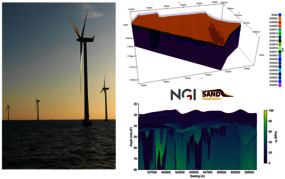Geophysics and machine learning in 3D ground modeling for offshore geotechnical design: example of the IJmuiden Ver Wind Farm Zone
The Cone Penetration Test (CPT) is a key practice in offshore site investigation, providing engineering parameters needed to design foundations for offshore wind turbines. However, as wind farm sites become larger and located in areas of increasing geological complexity, relying solely on costly, point-based CPTs becomes impractical. Consequently, site-wide geophysical surveys are increasingly used to understand the subsurface between these discrete test locations. The quantitative use of this data begins by interpreting seismic profiles alongside CPT and borehole data to build a cohesive 3D structural ground model. To determine predicted CPT parameters in 3D, geostatistical and machine learning approaches are used, allowing for the prediction of engineering parameters across the entire site and enabling optimized and cost-effective foundation design. This presentation covers the state-of-the-art in quantitative ground modelling for offshore wind and highlights some areas for future research.

